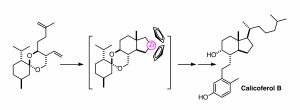Delaware is a small state wedged between Philadelphia and the Atlantic Ocean. We are home to Dupont, Hercules, Incyte Pharmaceuticals and Montell. Northern Delaware, in an area perhaps 12 miles by 20 miles, has more than 2,000 members of the American Chemical Society. For a visual tour of the Lammot DuPont Laboratory, see LDL tour.
Overview: Our research centers on the enantioselective synthesis of complex, physiologically active natural products. To this end, we are interested in developing new organic reactions, as illustrated by our current work with intramolecular alkylidene carbene insertion. We are also interested in using computational organometallic chemistry to understand catalysis, as exemplified by our recent analysis of diastereoselectivity in rhodium mediated intramolecular C-H insertion. For an overview of our current approaches to computationally-based catalyst design, see computational catalyst design. Using this same computational approach, we have developed a model for zirconium mediated cyclization that effectively predicts both the kinetic and the thermodynamic product from intramolecular cyclozirconation of a diene.
If you would like to subscribe to our weekly ORGANIC HIGHLIGHTS, send me an email at taberdf@udel.edu. The first sixteen years of this column are available in book form: Organic Synthesis: State of the Art 2003-2005 and Organic Synthesis: State of the Art 2005-2007 from Wiley, and Organic Synthesis: State of the Art 2007-2009, 2009-2011, 2011-2013, and 2013-2015 from Oxford University Press. Organic Synthesis: State of the Art 2015-2017 and Organic Synthesis: State of the Art 2017-2019 can be ordered at Organic Synthesis: State of the Art 2015-2017 for $110 each, shipping included. Those will NOT be available on Amazon. These volumes include cumulated author and transformation indices, and together constitute a useful field guide to organic synthesis as it is practiced in the 21st century.
Potasssium Hydride in Paraffin – KH(P): Potassium hydride in paraffin, called KH(P), is now available in bulk from Stereochemical, Inc, (302) 266-0700. This is an inexpensive and convenient solid form of KH, stable to water and easily weighed out in air [J. Org. Chem. 71: 8973-8974 (2006)].
For a 12-slide PowerPoint presentation on global warming, see Warming.ppt
Courses:
Chemistry 331: For course information, see Chem 331.
Chemistry 332: For course information, see Chem 332.
Chemistry 333: For course information, see Chem 333.
Chemistry 334: For course information, see Chem 334.
Chemistry 635: For course information, see Chem 635.
Sophomore Organic Lecture: One objective of sophomore organic chemistry is to enable each student to construct their knowledge of organic structures. The efficacy of the guided inquiry/problem-based learning approach to instruction in organic chemistry has been well documented, particularly in the laboratory course. Incorporating guided inquiry into the sophomore organic lecture course has been more challenging, especially early in the course. It is particularly difficult to formulate questions for the first hour exam that test the developing reasoning of the student. A way to approach this is to include H-coupled 13C NMR early in the course, with appropriate in class and homework problems to give the student the opportunity to practice. For an outline of this approach, with examples,see 13C NMR. To instill competence in drawing arrow-pushing mechanisms, see Arrow. To teach the fluidity of covalent bonds, using raspberry jam as a model, see Raspberry.
Spectroscopy Problems: As part of the undergraduate organic course, we enjoy using spectroscopic data sets to deduce the structure of organic unknowns. An interesting problem is posted at #1. For a growing set of integrated problems (starting material, conditions, spectroscopic data for the product) with a separate file for the answers see Chem 334. For a diverse collection of problems, detailed instructions at the undergraduate level on how to solve them, as well as the necessary data tables, see Organic Spectroscopic Structure Determination: A Problem Based Learning Approach, available from Oxford University Press (ISBN = 978-0-19-531470-0). For detailed instructions on solving the problems, see SpecBook.
Experiments for the Organic Teaching Lab: Organic Chemistry Laboratory: Standard and Microscale Experiments, by Bell, Clark, Taber and Rodig, available from Cengage (ISBN 0-03-029272-7) includes several new experiments that our students have found to be particularly appealing. For more, see Organic Chem Lab. The purpose of this site is to serve as a clearinghouse for new experiments that are suitable for the undergraduate laboratory course. Even if your experiment is already published, for instance in the Journal of Chemical Education, we would encourage you to post it here also. We hope that this site will serve two purposes: to share useful new procedures with each other, and to let the enthusiastic instructor know what already has been done.
3-D on the Web! You really can see true 3-D on the web. Give it a try at Stereo.
Latter Day Saint Student Association: An undergraduate group devoted to religious study, socializing and community service. For more information, see LDSSA
The entire contents of the pages indexed here Copyright 2002-2021 Douglass F. Taber
